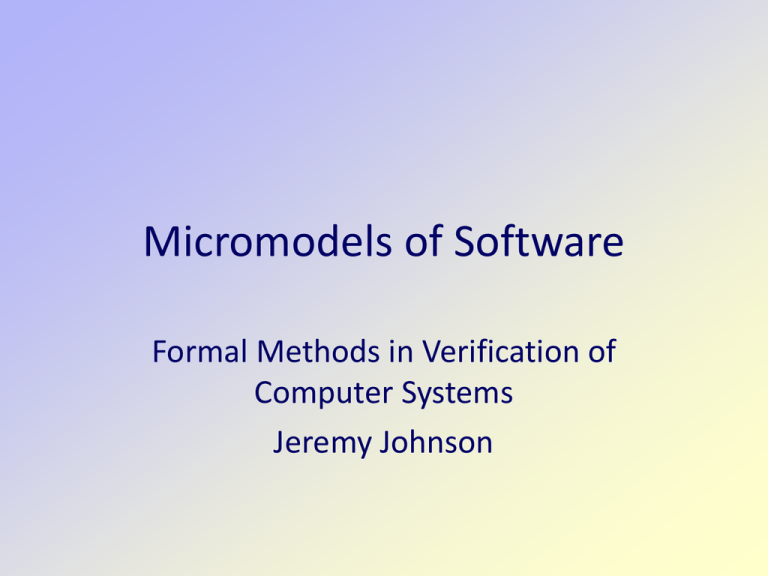micromodel
advertisement

Micromodels of Software
Formal Methods in Verification of
Computer Systems
Jeremy Johnson
Outline
1. Semantic Entailment
•
•
•
Given a set of formulas , is ⊨ valid
encodes requirements and as a property
that all valid implementations should have
Undecidable
2. Model checking
•
•
•
Given a formula and a matching model M
determine whether M ⊨l holds
Requirements encoded in model
Fixes too many implementation choices
Outline
1. Combination
•
•
•
Set of models (bounded size)
Negative answer provides counter example
Positive answer gives confidence
2. Small scope hypothesis
•
Negative answers tend to occur in small
models
3. Alloy (alloy.mit.edu)
Models
• Let F be a set of functions and P a set of
predicates. A model M for (F,P) consists of
• A non-empty set A [universe] of concrete
values
• For each nullary f F an element of A = fM
• For each n-ary f F a function fM : An A
• For each n-ary P P a subset PM An
Satisfaction
• Given a model M for (F,P) and given an
environment l : var A the satisfaction
relation M ⊨l
• P(t1,…,tn) (a1,…,an) and M ⊨l iff (a1,…,an)
RM
• M ⊨l x iff M ⊨l [x a] holds for all a A
• M ⊨l x iff M ⊨l [x a] holds for some a
A
Satisfaction
• Given a model M for (F,P) and given an
environment l : var A the satisfaction
relation M ⊨l
•
•
•
•
M ⊨l iff M ⊨l does not hold
M ⊨l 1 2 iff M ⊨l 1 and M ⊨l 2 holds
M ⊨l 1 2 iff M ⊨l 1 or M ⊨l 2 holds
M ⊨l 1 2 iff M ⊨l 2 holds whenever M
⊨l 1 holds
Semantic Entailment
• Let be a set of formulas (possibly
infinite) and be a formula from
predicate calculus
• ⊨ holds iff for all models M and lookup
tables l, whenever M ⊨l holds for all
then M ⊨l holds as well
• is satisfiable iff there is some model M and
lookup table l such that M ⊨l holds
• is valid iff M ⊨l holds for all models M
and lookup tables l
Example 1
• F = {i} and P = {R,F}
• i a constant function, R binary and F unary
predicates
• Model – A set of states, initial state i, state
transitions R, final states F
• A = {a,b,c}
• iM = a
• RM = {(a,a),(a,b),(a,c),(b,c), (c,c)}
• FM = {b,c}
Example 1
• y R(i,y)
• F(i)
• x y z (R(x,y) R(x,z) y = z )
• x y R(x,y)
Software Micromodels
• Want description M of all compliant
implementations Mi of some software
system.
• Given a property
• Assertion checking: does hold in all
implementations Mi M
• Consistency checking: does hold in some
implementations Mi M
Alloy (alloy.mit.edu)
• “Alloy is a language for describing structures and a tool for
exploring them. It has been used in a wide range of
applications from finding holes in security mechanisms to
designing telephone switching networks.”
• Declarative (language based on logic)
• Bounded queries
• Implemented using SAT solver
• Illustrate by describing concrete models of state machines
(example 1) and checking assertion that “final states are
not initial states) and consistency there are state
machines that contain a non-final state that is deadlocked
Alloy Implementation
module AboutStateMachines
sig State {}
-- simple states
sig StateMachine { -- composite state machines
A : set State, -- set of states of a state machine
i : A,
}
-- initial state of a state machine
F : set A,
-- set of final states of a state machine
R : A -> A
-- transition relation of a state machine
Alloy Implementation
-- E.G. assertion checking
-- Claim that final states are never initial: false.
assert FinalNotInitial {
all M : StateMachine | no M.i & M.F
} check FinalNotInitial for 3 but 1 StateMachine
S0
R
S1
S2
(F)
(I,F)
Alloy Implementation
-- E.G. consistency checking
-- Is there a three-state machine with a non-final deadlock? True.
pred AGuidedSimulation(M : StateMachine, s : M.A) {
no s.(M.R)
not s in M.F
# M.A = 3
} run AGuidedSimulation for 3 but 1 StateMachine
S0
R
S2
(I)
S1
(F)
R
Example 2
• F = {alma} and P = {loves}
• P is a binary predicates, alma constant
function
• Model – A set of states,
• A = {a,b,c}
• almaM = a
• lovesM = {(a,a),(b,a),(c,a)}
Example 2
• almaM = a
• lovesM = {(a,a),(b,a),(c,a)}
• lovesM’ = {(b,a),(c,b)}
• Does the model satisfy
• None of Alma’s lovers’ lovers love her
• xy (loves(x,alma) loves(y,x)
loves(y,alma)
Alloy Implementation
module AboutAlma
sig Person {}
sig SoapOpera {
cast : set Person,
alma : cast,
loves : cast -> cast
Person0
Alma
}
assert OfLovers {
all S : SoapOpera |
all x, y : S.cast |
S.alma in x.(S.loves) && x in y.(S.loves) =>
not S.alma in y.(S.loves)
}
check OfLovers for 2 but 1 SoapOpera
R
Person1
Underspecified System
• Add the following constaint
•
Fact NoSelfLove { all S : SoapOpera, p : S.cast |
not p in p.(S.loves) }
• No there are no counter examples
• Increase the number of persons to 3
provides the smallest counter example
• check OfLovers for 3 but 1 SoapOpera
Exercise
• Install alloy
• Go through the tutorial (file system
example)
• Study package dependency example from
section 2.7 of the text
• www.cs.bham.ac.uk/research/projects/lics
• Look under ancillary materials
• Note that code is for an older version of alloy
and some changes are necessary






